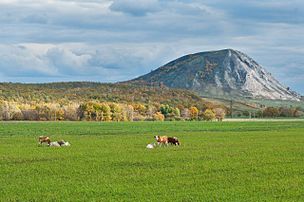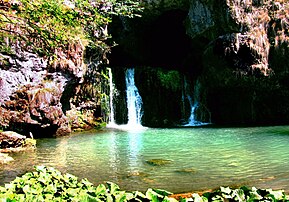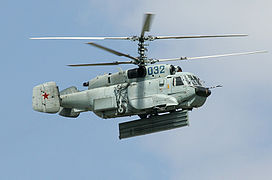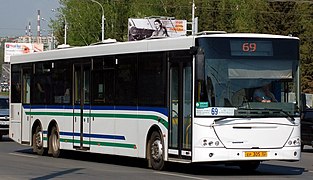Bashkortostan
Bashkortostan was established on 28 November [O.S. 15 November] 1917. On 20 March 1919 it was transformed into the Bashkir ASSR, the first autonomous republic in the Russian SFSR. On 11 October 1990, it adopted the Declaration of State Sovereignty. In the Constitution of Bashkortostan and Constitution of Russia, Bashkortostan is defined as a state.
Terminology
The name "Bashkortostan" derives from the name of the Bashkir ethnic group. While the endonym having various theories on its meaning, the most prominent is being a combination of Turkic words baş, meaning 'head', 'chief', 'main', 'principal' and qurt meaning 'wolf', one of the animals regarded as sacred to Turkic peoples); the suffix -stan is Persian, commonly used for many Eurasian territorial names. Bashkirs speak the Bashkir language, which belongs to the Kipchak branch of the Turkic language group.
History
The first settlements in the territory of modern Bashkortostan date from the early Paleolithic period, but the Bronze Age spurred an upsurge in the population of this territory. When people of the Abashevo culture started settling here, they possessed high skills in manufacturing bronze tools, weapons and decorations. They were the first to establish permanent settlements in the Southern Urals.
Bashkortostan takes its name from its native people, the Bashkirs. The Slavonic name of the country, Bashkiriya, formed at the end of the 16th century. Originally it appeared in the forms Bashkir land, Bashkir, Bashkirda and Bashkir horde. The ethnonym Bashkirs first became known in the 7th century. In the 10th century, Al-Balkhi wrote about Bashkirs as a people, divided into two groups, one of which inhabited the Southern Urals, while the other lived near the Danube River, close to the boundaries of Byzantium. His contemporary Ibn-Ruste described the Bashkirs as "an independent people, occupying territories on both sides of the Ural mountain ridge between Volga, Kama, Tobol and upstream of Yaik River".
-
Mausoleum of Turahan, 14th-century building.
-
Bashkirs near Hamburg during the Napoleonic Wars, c. 1813.
-
A Red Army cavalry unit made up of Bashkirs, likely taken between 1924 and 1927.
After the early-feudal Mongolian state had broken down in the 14th century, the territory of modern Bashkortostan became divided between the Kazan, the Siberia Khanates and the Nogai Horde. The tribes that lived there were headed by bi (tribal heads). After Kazan fell to Ivan the Terrible in 1554–1555, representatives of western and northwestern Bashkir tribes approached the Tsar with a request to voluntarily join Muscovy. The Bashkir rebellion of 1662–1664 and the Bashkir rebellion of 1704–1711 were primarily caused by the Russian government's violations of the terms and conditions previously agreed between the Bashkirs and the Russian authorities.

Starting from the second half of the 16th century, Bashkiria's territory began taking shape as a part of the Russian state. In 1798, the Spiritual Assembly of Russian Muslims was established, an indication that the tsarist government recognized the rights of Bashkirs, Tatars, and other Muslim nations to profess Islam and perform religious rituals. Ufa Governorate (guberniya), with a center in Ufa, was formed in 1865—another step toward territorial identification.
After the Russian Revolution of 1917 were the All-Bashkir Qoroltays (conventions), which required a decision on the need to create a national federal republic within Russia. As a result, on 28 November 1917, the Bashkir Regional (Central) Shuro (Council) proclaimed the establishment of territorial and national autonomy in areas of Orenburg, Perm, Samara, and Ufa provinces with a predominantly Bashkir population.
In December 1917, delegates to the All-Bashkir (constituent) Congress, representing the interests of the population edge of all nationalities, voted unanimously for the resolution (Farman #2) of the Bashkir regional Shuro for the proclamation of national-territorial autonomy (of the Republic) Bashkurdistan. The congress formed the government of Bashkurdistan, the Pre-parliament—Kese-Qoroltay and other bodies of power and administration, and decisions were made on how to proceed.
In March 1919, based on the agreements of the Russian Government, the Bashkir Autonomous Soviet Socialist Republic was formed. During the Soviet period, Bashkiria was granted broad autonomous rights, the first among other Russian regions. The administrative structure of the Bashkir ASSR was based on principles similar to those of other autonomous republics of Russia.
On 11 October 1990, the Supreme Soviet of the Republic adopted the declaration on state sovereignty of the Bashkir ASSR. On 25 February 1992, the Bashkir ASSR was renamed the Republic of Bashkortostan.
On 31 March 1992, a Federative Compact "On separation of authorities and powers among federal organs of power of the Russian Federation and the organs of power of the Republic of Bashkortostan" was signed. On 3 August 1994, a Compact "On separation of authorities and mutual delegating of powers among the organs of power of the Russian Federation and the organs of power of the Republic of Bashkortostan" was signed, granting the republic autonomy. This agreement was unilaterally abolished on 7 July 2005.
Geography
Bashkortostan contains part of the southern Urals and the adjacent plains.
-
Shihan Toratau. Single hills are popular symbols of Bashkortostan.
-
Atysh waterfall
-
Bashkir horses near Yakty-Kul lake
-
Autumn Yamantau
- Area: 143,600 square kilometers (55,400 sq mi) (according to the 2002 Census)
- Borders: Bashkortostan borders with Perm Krai (N), Sverdlovsk Oblast (NE), Chelyabinsk Oblast (NE/E/SE), Orenburg Oblast (SE/S/SW), the Republic of Tatarstan (W), and the Udmurt Republic (NW)
- Highest point: Mount Yamantau (1,638 m)
- Maximum north-south distance: 550 km
- Maximum east-west distance: over 430 km
Rivers

There are over 13,000 rivers in the republic. Many rivers are part of the deep-water transportation system of European Russia; they provide access to ports of the Baltic and Black seas.
Major rivers include:
- Belaya (Aghidhel) River (1,430 km)
- Ufa (Qaraidel) River (918 km)
- Sakmara River (760 km)
- Ik (Iq) River (571 km)
- Dyoma (Dim) River (556 km)
- Ay River (549 km)
- Yuruzan River (404 km)
- Bystry Tanyp River (345 km)
- Sim River (239 km)
- Nugush River (235 km)
- Tanalyk River (225 km)
- Zilim (Yethem) River (215 km)
- Syun River (209 km)
Lakes
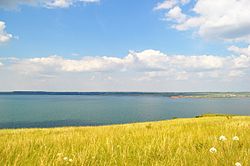
There are 2,700 lakes and reservoirs in the republic. Major lakes and reservoirs include:
- Asylykül Lake (23.5 km)
- Qandrykül Lake (15.6 km)
- Urgun Lake (12.0 km)
- Pavlovskoye Reservoir (120.0 km)
- Nugushkoye Reservoir (25.2 km)
Mountains
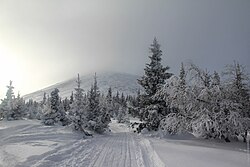
The Republic contains part of the southern Urals, which stretch from the northern to the southern border. The highest mountains include:
- Mount Yamantau (1,638 m)
- Mount Bolshoy Iremel (1,582 m)
- Mount Maly Iremel (1,449 m)
- Mount Arwyakryaz (1,068 m)
- Mount Zilmerdaq (909 m)
- Mount Alataw (845 m)
- Mount Yurmataw (842 m)
Natural resources
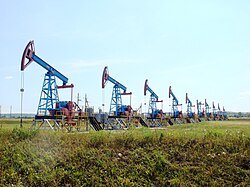

The Republic of Bashkortostan is one of Russia's most mineral-rich territories. With a large share of Russian oil reserves, the region is a principal site of extraction. Other major resources are natural gas, coal, ferrous metal ores, manganese, chromite, and more.
The republic has enough mineral resources to provide its own power and fuel. Additionally, the region has enough raw materials to support a variety of industries, from metallurgy to glass-making.
Bashkortostan is a major source of materials used in non-ferrous metallurgy. The republic has good deposits of lignite with a high degree of bitumen. This lignite can be used for obtaining a variety of different chemical products like resins, surface-active substances, gummy fertilizers, and other stimulants for plant growth. Deposits of raw materials used in mining are also significant in the region.
Bashkortostan is also rich in woodlands. Over one-third of its territory, or 62,000 square kilometres (24,000 sq mi), is wooded. The following types of trees dominate: birch, conifers, lime, oak, and maple. The general stock of timber has been estimated as 717.9 million m. Bashkortostan forests have special sanctuaries and national parks. They cover more than 10,000 square kilometres (3,900 sq mi).
Bashkortostan is also rich in springs that provide drinking water.
The Asselian Age at the start of the Permian Period of geological time is named after the Assel River in Bashkortostan.
Climate
- Average annual temperature: +0.3 °C (32.5 °F) (mountains) to +2.8 °C (37.0 °F) (plains)
- Average January temperature: −16 °C (3 °F)
- Average July temperature: +18 °C (64 °F)


Administrative divisions
As of 2013, Republic of Bashkortostan is divided into 54 districts, 21 cities or towns, 2 urban type settlements and 827 selsoviets.
Politics

The head of the government of the Republic of Bashkortostan is called the Head (before 1 January 2015 the title was "President"). According to the Constitution, the Head of the Republic of Bashkortostan guarantees rights and liberties to the country's people and citizens, protects the economic and political interests of the Republic of Bashkortostan, and secures legitimacy, law, and order within its territory.
Since 11 October 2018, the Head of the Republic of Bashkortostan has been Radiy Khabirov. He was first appointed as acting head by Russian President Vladimir Putin. In 2019 he was elected after winning 82% of the vote in the 2019 Bashkir head election. The next election will be in 2024. Before his current role, Radiy Khabirov was the Head of Krasnogorsk, Moscow Oblast. His predecessor was Rustem Khamitov, the leader after 19 July 2010. He resigned on 11 October 2018 ahead of the election because he decided to not run for reelection.
The Republic's parliament is the State Assembly—Kurultai, popularly elected every five years. The one-chamber State Assembly has 110 deputies.

The Republic's Constitution was adopted on 24 December 1993. Article 1 of the Constitution stipulates that Bashkortostan is a sovereign state within Russia, it has state power beyond the limits of the authority of the Russian Federation and the powers of the Russian Federation concerning the aspect of the joint authority of the Russian Federation and the Republic of Bashkortostan. The Republic of Bashkortostan is a full-fledged subject of the Russian Federation on equal and agreed bases.
The relations of the Republic of Bashkortostan and the Russian Federation are based on the articles of the Constitution of the Russian Federation, the Constitution of the Republic of Bashkortostan, the Federative Treaty (with amendments) and the Agreement on Separation of authorities and powers and mutual delegating of powers among the organs of state power of the Republic of Bashkortostan.
The judicial power of the republic is in the hands of the Supreme Court, the Court of Appeals, district courts, and justices of the peace.
In full accord with universally recognized principles of international law, articles of the European Charter of Local Self-Government and the Constitution of the Russian Federation, the Republic of Bashkortostan ensures in its Constitution that local self-government is recognized and guaranteed within the republic's territory.
The Republic of Bashkortostan resolves all issues of administrative-territorial structure on its own. The list of districts and towns, municipalities, as well as the order of establishing, amending and changing borders of municipalities and their names, are stipulated by the Republic of Bashkortostan law "On administrative-territorial structure of the Republic of Bashkortostan and territory of municipalities".
The state has strong economic and cultural ties with its western neighbour, the Republic of Tatarstan.
Economy

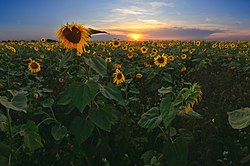
Bashkortostan is one of the Russian Federation's most developed regions in terms of its cross-regional output, the volume of industrial production, agricultural production, and investment in fixed assets.
The region's largest companies include Bashneft, Ufa Engine Industrial Association (part of United Engine Corporation), Peton Holding, Bashkhim, Ufaorgsintez, Beloretsk Iron and Steel Works.
The extraction of crude oil in Bashkiria began in 1932. with major deposits first discovered in 1943. During the Great Patriotic War, Bashkiria became one of the major regions of the Soviet Union to accommodate plants and factories evacuated from Western Russia, as well as great masses of people, while also providing the country with weaponry, fuel, and foodstuffs. After the war, several industries developed further in Bashkiria, such as mining (Bakr-Tay and Blyavinsky copper mines), machine-building and oil-refining. Bashkiria's industry became a base for the further economic growth of all European outlying territories of Russia.
Bashkortostan has a diverse economy, including a large agricultural sector. But the republic's most important industry is chemical processing. Bashkortostan produces more oil than any other region of Russia, about 26 million tons annually, and provides 17% of the country's gasoline and 15% of its diesel fuel. Other important products manufactured in Bashkortostan include alcohols, pesticides, and plastics.
Bashkortostan's gross regional product (GRP) in 2016 was 1.34 trillion rubles, making the republic the subject with the ninth-highest GRP in Russia. The state had a positive trade balance, with $13.7 billion exported and $1.2 billion imported in 2013. As much as 82.9% of enterprises in Bashkortostan are profitable, higher than the nationwide average of 68.42%. Bashkortostan has been recognized as the region with the lowest economic risk.
Bashkortostan is among the leaders in real estate development, developed electric power industry and tourism.
Ufa was ranked by Forbes as among the best cities for business in Russia in 2013.
Structure of GRP
GRP structure of Bashkortostan for 2013.
| Sector | % |
|---|---|
| Manufacturing | 36.2 |
| Wholesale and retail trade | 16.7 |
| Transport and communications | 7.3 |
| Real estate transactions | 7 |
| Construction | 6.9 |
| Agriculture | 6.5 |
| Education | 4.1 |
| Healthcare and social services | 4.1 |
| State management and social insurance | 3.8 |
| Mining | 2.8 |
| Production of electricity, gas, water | 2.4 |
| Hotels and restaurants | 1.1 |
| Other | 1.1 |
- Some industrial products of Bashkortostan
-
Nefaz-VDL bus of Neftekamsk Automotive Plant.
Tourism

Tourism in the region is regulated by the Russian Federation. Efforts are underway to enhance tourism and hospitality in the northeast region. These initiatives are founded on the innovative scientific, educational, and industrial infrastructure of the Geopark "Yangan-Tau."
Demographics
Settlements
Largest cities or towns in Bashkortostan
2010 Russian Census | |||||||||
|---|---|---|---|---|---|---|---|---|---|
| Rank | Name | Administrative Division | Pop. | ||||||
 Ufa  Sterlitamak |
1 | Ufa | Ufimsky District | 1,062,319 |  Salavat  Neftekamsk | ||||
| 2 | Sterlitamak | Sterlitamaksky District | 273,486 | ||||||
| 3 | Salavat | City of republic significance of Salavat | 156,095 | ||||||
| 4 | Neftekamsk | City of republic significance of Neftekamsk | 121,733 | ||||||
| 5 | Oktyabrsky | City of republic significance of Oktyabrsky | 109,474 | ||||||
| 6 | Beloretsk | Beloretsky District | 68,806 | ||||||
| 7 | Tuymazy | Tuymazinsky District | 66,836 | ||||||
| 8 | Ishimbay | Ishimbaysky District | 66,259 | ||||||
| 9 | Kumertau | Town of republic significance of Kumertau | 62,851 | ||||||
| 10 | Sibay | Town of republic significance of Sibay | 62,763 | ||||||
| Year | Pop. | ±% |
|---|---|---|
| 1897 | 1,991,000 | — |
| 1926 | 2,545,165 | +27.8% |
| 1939 | 3,158,000 | +24.1% |
| 1959 | 3,341,609 | +5.8% |
| 1970 | 3,818,075 | +14.3% |
| 1979 | 3,848,627 | +0.8% |
| 1989 | 3,950,482 | +2.6% |
| 2002 | 4,104,336 | +3.9% |
| 2010 | 4,072,292 | −0.8% |
| 2021 | 4,091,423 | +0.5% |
| Source: Census data | ||


Ethnic groups
Bashkirs are the indigenous (autochthonal) peoples of Bashkortostan. According to the 2021 Census, the ethnic composition was:
- Russians 37.5%
- Bashkirs 31.5%
- Volga Tatars 24.2%
- Mari 2.1%
- Chuvash 2.0%
- Udmurts 0.4%
- Ukrainians 0.4%
| Ethnic group |
1920 Census | 1926 Census | 1939 Census | 1959 Census | 1970 Census | 1979 Census | 1989 Census | 2002 Census | 2010 Census | 2021 Census | ||||||||||
|---|---|---|---|---|---|---|---|---|---|---|---|---|---|---|---|---|---|---|---|---|
| Number | % | Number | % | Number | % | Number | % | Number | % | Number | % | Number | % | Number | % | Number | % | Number | % | |
| Bashkirs | 807,213 | 40.13% | 625,845 | 23.5% | 671,188 | 21.2% | 737,744 | 22.1% | 892,248 | 23.4% | 935,880 | 24.3% | 863,808 | 21.9% | 1,221,302 | 29.8% | 1,172,287 | 29.5% | 1,268,806 | 31.5% |
| Russians | 794,131 | 39.48% | 1,064,707 | 39.9% | 1,281,347 | 40.6% | 1,418,147 | 42.4% | 1,546,304 | 40.5% | 1,547,893 | 40.3% | 1,548,291 | 39.3% | 1,490,715 | 36.3% | 1,432,906 | 36.1% | 1,509,246 | 37.5% |
| Tatars | 103,928 | 5.17% | 461,871 | 17.3% | 777,230 | 24.6% | 768,566 | 23.0% | 944,505 | 24.7% | 940,436 | 24.5% | 1,120,702 | 28.4% | 990,702 | 24.1% | 1,009,295 | 25.4% | 974,533 | 24.2% |
| Mari | 84,809 | 4.22% | 79,298 | 3.0% | 90,163 | 2.9% | 93,902 | 2.8% | 109,638 | 2.9% | 106,793 | 2.8% | 105,768 | 2.7% | 105,829 | 2.6% | 103,658 | 2.6% | 84,988 | 2.1% |
| Chuvash | 47,929 | 2.38% | 84,886 | 3.2% | 106,892 | 3.4% | 109,970 | 3.3% | 126,638 | 3.3% | 122,344 | 3.2% | 118,509 | 3.0% | 117,317 | 2.9% | 107,450 | 2.7% | 79,950 | 2.0% |
| Udmurts | 23,907 | 1.32% | 23,256 | 0.9% | 25,103 | 0.8% | 25,388 | 0.8% | 27,918 | 0.7% | 25,906 | 0.7% | 23,696 | 0.6% | 22,625 | 0.6% | 21,477 | 0.5% | 17,149 | 0.4% |
| Ukrainians | 57,024 | 2.84% | 76,710 | 2.9% | 99,289 | 3.1% | 83,594 | 2.5% | 76,005 | 2.0% | 75,571 | 2.0% | 74,990 | 1.9% | 55,249 | 1.3% | 39,875 | 1.0% | 14,876 | 0.4% |
| Others | 5,103 | 0.12% | 249,263 | 9.3% | 107,757 | 3.4% | 104,298 | 3.1% | 94,819 | 2.5% | 87,445 | 2.3% | 87,349 | 2.2% | 96,231 | 2.3% | 87,772 | 2.2% | 75,819 | 1.9% |
| 66,056 people were registered from administrative databases, and could not declare an ethnicity. It is estimated that the proportion of ethnicities in this group is the same as that of the declared group. | ||||||||||||||||||||
Languages
According to the 2021 Census, spoken languages: Russian (97%), Bashkir (23%) and Tatar (20%).
Religion

Islam is adhered to by a majority of the nation's population of Bashkir and Tatar descent. The Muslims of Bashkortostan follow the Sunni Hanafi school of Islamic law.
Most ethnic Russians, Chuvash, and Ukrainians are Orthodox Christians. Most Mari are Pagan. Non-religious people form a substantial part of any ethnic group in Bashkortostan. There are 13,000 Jews in the republic, with a historic synagogue in Ufa, and a new Jewish Community Center built in 2008.
According to a 2012 Sreda survey of 56,900 people, 58% of the population of Bashkortostan are Muslim, 17% adhere to the Russian Orthodox Church, 3% are unaffiliated generic Christians, 1% are Orthodox Christian believers without belonging to any church or members of other Orthodox churches, and 2% are adherents of the Slavic native faith (Rodnovery), the Mari native religion, Chuvash Vattisen Yaly or Tengrism. In addition, 4% of the population declare to be "spiritual but not religious", 5% are atheist, and 7% follow other religions or did not give an answer to the question. Note, however, that this survey has been criticized as biased. It was conducted by the service "Sreda", which has ties to the Christian organizations.
In 2010, there were over 1,000 mosques in Bashkortostan, 200 Orthodox churches and 60 religious buildings of other confessions.
Education
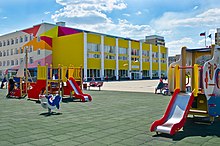
About sixty scientific organizations are active in the republic. Fundamental and applied scientific research is underway at 12 institutes of the Russian Academy of Sciences, 29 institutes of different branches of industry, as well as numerous design bureaus and organizations, universities, and colleges.
The country's system of popular education took shape over many centuries and reflects the Bashkir people's folklore, national customs, and traditions. When Islam spread in Bashkiria in the 10th century, an educational system began to emerge gradually—primarily religious schools operated under the supervision of mosques (maktabeh and madrasah).
In addition, many institutions of higher education operate in the republic, including branches of 16 leading Russian universities and colleges. Specialists graduate with degrees in about 200 trades and professions.
Education is primarily in Russian and Bashkir.
Sport
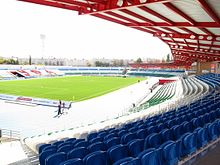
Russian Premier League football club FC Ufa is from Ufa. KHL team Salavat Yulaev Ufa plays in the city, as does Supreme Hockey League team Toros Neftekamsk, Minor Hockey League team Tolpar Ufa and Russian Women's Hockey League team Agidel. Russian Volleyball Super League team Ural and volleyball team Samrau-UGNTU are from Ufa. Russian Handball Super League team Ugntu-VNZM and Russian Women's Handball Super League team Ufa-Alisa are from Ufa. Formula One driver Daniil Kvyat hails from Ufa. It was decided in 2018 to revive bandy. There are even preliminary plans for building an indoor arena.
Culture
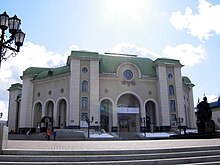
Bashkortostan is home to song and dance companies, a network of national theaters, museums, and libraries, and a number of annual folk festivals. The republic has seven Bashkir, four Russian, and two Tatar State Drama Theaters, a State Opera and Ballet Theater, a National Symphony Orchestra, "Bashkortostan" film studio, thirty philharmonic collectives, and the Bashkir State Folk Dance Ensemble.
The Bashkir School of Dance is well respected, with many students receiving international awards at competitions in Russia and other countries. World-renowned ballet dancer Rudolf Nureyev, as a child, was encouraged to dance in Bashkir folk performances, and began his dancing career in Ufa.
Bashkir literature is the literary tradition of the Republic of Bashkortostan.
There are many museums in the Republic that chronicle the region's history. The National Museum of the Republic of Bashkortostan, the Bashkir Nesterov Art Museum, the Museum of Archeology and Ethnography are the largest of them.
See also
Notes
- ^ UK: /bæʃˈkɔːrtəstɑːn/ bash-KOR-tə-stahn, US: /bɑːʃˈ-/ bahsh-; Bashkir: Башҡортостан, romanized: Bashqortostan; Russian: Башкортостан, romanized: Bashkortostan, IPA: [bəʂkərtɐˈstan].
- ^ Russian: Башкирия, romanized: Bashkiriya, IPA: [bɐʂˈkʲirʲɪjə].
- ^ Bashkir: Башҡортостан Республикаһы, romanized: Bashqortostan Respublikahy; Russian: Республика Башкортостан, romanized: Respublika Bashkortostan, IPA: [rʲɪsˈpublʲɪkə bəʂkərtɐˈstan].
References
- ^ Президент Российской Федерации. Указ №849 от 13 мая 2000 г. «О полномочном представителе Президента Российской Федерации в федеральном округе». Вступил в силу 13 мая 2000 г. Опубликован: "Собрание законодательства РФ", No. 20, ст. 2112, 15 мая 2000 г. (President of the Russian Federation. Decree #849 of May 13, 2000 On the Plenipotentiary Representative of the President of the Russian Federation in a Federal District. Effective as of May 13, 2000.).
- ^ Law #10-z
- ^ Госстандарт Российской Федерации. №ОК 024-95 27 декабря 1995 г. «Общероссийский классификатор экономических регионов. 2. Экономические районы», в ред. Изменения №5/2001 ОКЭР. (Gosstandart of the Russian Federation. #OK 024-95 December 27, 1995 Russian Classification of Economic Regions. 2. Economic Regions, as amended by the Amendment #5/2001 OKER. ).
- ^ Constitution of the Republic of Bashkortostan, Article 6
- ^ "Путин назначил врио глав Курской области и Башкирии". Vedomosti.ru. October 11, 2018. Archived from the original on October 11, 2018. Retrieved October 11, 2018.
- ^ "Оценка численности постоянного населения по субъектам Российской Федерации". Federal State Statistics Service. Archived from the original on September 1, 2022. Retrieved September 1, 2022.
- ^ "Об исчислении времени". Официальный интернет-портал правовой информации (in Russian). Archived from the original on June 22, 2020. Retrieved January 19, 2019.
- ^ Constitution of the Republic of Bashkortostan, Article 65
- ^ Constitution of the Republic of Bashkortostan, Article 1
- ^ Official throughout the Russian Federation according to Article 68.1 of the Constitution of Russia.
- ^ Федеральная служба государственной статистики (Federal State Statistics Service) (May 21, 2004). "Territoriya, chislo rayonov, naselonnykh punktov i sel'skikh administratsiy po sub"yektam Rossiyskoy Federatsii" Территория, число районов, населённых пунктов и сельских администраций по субъектам Российской Федерации [Territory, Number of Districts, Inhabited Localities, and Rural Administration by Federal Subjects of the Russian Federation]. Всероссийская перепись населения 2002 года (All-Russia Population Census of 2002) (in Russian). Federal State Statistics Service. Archived from the original on September 28, 2011. Retrieved November 1, 2011.
- ^ "Bashkortostan". Collins English Dictionary. HarperCollins. Retrieved July 12, 2024.
- ^ "Bashkortostan". Merriam-Webster.com Dictionary. Merriam-Webster. Retrieved July 12, 2024.
- ^ "BASHKIR : Cyrillic script" (PDF). Transliteration.eki.ee. Archived (PDF) from the original on February 7, 2022. Retrieved March 2, 2022.
- ^ Russian Federal State Statistics Service (2011). Всероссийская перепись населения 2010 года. Том 1 [2010 All-Russian Population Census, vol. 1]. Всероссийская перепись населения 2010 года [2010 All-Russia Population Census] (in Russian). Federal State Statistics Service.
- ^ Национально-государственное устройство Башкортостана, 1917–1925 гг: Общее введение и Том 1 // Билал Хамитович Юлдашбаев, Китап, 2002, ISBN 5295029166, 9785295029165
- ^ Хрестоматия по истории Башкортостана: Документы и материалы с древнейших времен до 1917 года // Фарит Гумеров, "Китап", 2001
- ^ Зулькарнаева Е. З., Кульшарипова Н. М. Фарман. // Башкортостан: краткая энциклопедия. — Уфа: Башкирская энциклопедия, 1996. — С. 603. — 672 с. — ISBN 5-88185-001-7.
- ^ Administrative-Territorial Structure of the Union Republics. 1987., p. 25
- ^ БСЭ т.4 1950 год стр 347
- ^ Smele, Jonathan D. (November 19, 2015). Historical Dictionary of the Russian Civil Wars,1916–1926. Vol. 2. Rowman & Littlefield Publishers. p. 179. ISBN 978-1442252806.
- ^ The Encyclopedia Americana. Vol. 30. Danbury, Conn. : Grolier. 1984. p. 310. ISBN 0717201155.
- ^ "President of Russia". Archived from the original on January 8, 2016. Retrieved January 24, 2016.
- ^ "Konstitutsiya Respubliki Bashkortostan ot 24 dekabrya 1993 g. N VS-22/15 / Glava 1. Osnovy konstitutsionnogo stroya Respubliki Bashkortostan" Конституция Республики Башкортостан от 24 декабря 1993 г. N ВС-22/15 / Глава 1. Основы конституционного строя Республики Башкортостан [Constitution of the Republic of Bashkortostan dated December 24, 1993 N ВС-22/15 / Chapter 1. Fundamentals of the constitutional order of the Republic of Bashkortostan]. Constitution/garant/ru (in Russian). Archived from the original on September 30, 2011. Retrieved January 24, 2016.
- ^ Rinchindorji; Ying, Lang (February 5, 2020). THE EPICS OF CHINA. American Academic Press. ISBN 978-1-63181-660-4.
- ^ Encyclopedia of Language and Linguistics. Elsevier. November 24, 2005. ISBN 978-0-08-054784-8.
- ^ "Главархитектура г. Уфы – История г. Уфы". Gorodufa.ru. Archived from the original on August 31, 2021. Retrieved August 26, 2015.
- ^ Ross, Cameron (May 3, 2002). Regional Politics in Russia. Manchester University Press. ISBN 978-0-7190-5890-5. Archived from the original on January 25, 2024. Retrieved September 15, 2023.
- ^ Об изменении наименования государства Башкирская Советская Социалистическая Республика / Закон Республики Башкортостан от 25 февраля 1992 г. № ВС-10/12
- ^ Solnick, Steven (May 29, 1996). "Asymmetries in Russian Federation Bargaining" (PDF). The National Council for Soviet and East European Research: 12. Archived from the original (PDF) on August 28, 2017. Retrieved May 3, 2019.
- ^ Turner, Cassandra (May 2018). "We Never Said We're Independent": Natural Resources, Nationalism, and the Fight for Political Autonomy in Russia's Regions (Undergraduate thesis). University of Mississippi. p. 49.
As the treaty was not successfully re-approved, Bashkortostan lost its autonomy on July 7th, 2005.
- ^ Lucas, Spencer G.; Zeigler, Kate E., eds. (2005). "The Nonmarine Permian". Bulletin of the New Mexico Museum of Natural History and Science. 30: 48.
- ^ Государственный комитет Российской Федерации по статистике. Комитет Российской Федерации по стандартизации, метрологии и сертификации. №ОК 019-95 1 января 1997 г. «Общероссийский классификатор объектов административно-территориального деления. Код 80», в ред. изменения №278/2015 от 1 января 2016 г.. (State Statistics Committee of the Russian Federation. Committee of the Russian Federation on Standardization, Metrology, and Certification. #OK 019-95 January 1, 1997 Russian Classification of Objects of Administrative Division (OKATO). Code 80, as amended by the Amendment #278/2015 of January 1, 2016. ).
- ^ "Parlamentarii Bashkirii prinyali Zakon "O Glave Respubliki Bashkortostan"" Парламентарии Башкирии приняли Закон "О Главе Республики Башкортостан" [Parliamentarians of Bashkiria adopted the Law "On the Head of the Republic of Bashkortostan"]. Bashinform.ru (in Russian). December 25, 2014. Archived from the original on January 9, 2015. Retrieved January 8, 2015.
- ^ "Glava Bashkirii Khamitov ushel v otstavku" Глава Башкирии Хамитов ушел в отставку [Head of Bashkiria Khamitov resigned]. Interfax.ru (in Russian). October 11, 2018. Archived from the original on October 11, 2018. Retrieved June 3, 2022.
- ^ "Prosmotr publikatsii : Respublika Tatarstan" Просмотр публикации : Республика Татарстан [View Publication : Republic of Tatarstan] (in Russian). Archived from the original on January 30, 2016. Retrieved January 24, 2016.
- ^ "IslamRF.ru: Татарстан и Башкортостан в первой половине 2012–го года: от альянса в экономике к сотрудничеству в сферах языка и религии". Islamrf.ru. Archived from the original on November 20, 2012. Retrieved January 24, 2016.
- ^ "Президент РТ". Archived from the original on January 31, 2016. Retrieved January 24, 2016.
- ^ Выписки ЕГРЮЛ и ЕГРИП, проверка контрагентов, ИНН и КПП организаций, реквизиты ИП и ООО. СБИС (in Russian). Archived from the original on October 21, 2018. Retrieved October 20, 2018.
- ^ "ВРП Башкирии в 2014 году преодолел новый рубеж — 1,3 трлн рублей". Bashinform.ru. March 12, 2015.
- ^ "Республика Башкортостан в цифрах и фактах". Pobashkirii.ru. Archived from the original on March 2, 2022. Retrieved March 2, 2022.
- ^ "РЕЙТИНГ СОЦИАЛЬНО-ЭКОНОМИЧЕСКОГО ПОЛОЖЕНИЯ СУБЪЕКТОВ РФ ИТОГИ 2014 ГОДА" (PDF). Vid1..rian.ru. Archived (PDF) from the original on July 6, 2015. Retrieved March 2, 2022.
- ^ "Вести.Ru: Башкортостан признан регионом с минимальными экономическими рисками". Vesti.ru. Archived from the original on May 29, 2014. Retrieved January 24, 2016.
- ^ "Title". Archived from the original on February 8, 2016. Retrieved August 24, 2015.
- ^ "Ввод жилья в России – 2014: рейтинг регионов по итогам III квартала". Top-rf.ru. Archived from the original on January 31, 2016. Retrieved January 24, 2016.
- ^ "Сайт газеты "Республика Башкортостан" – Экономика – "Позеленеет" ли энергетика?". Resbash.ru. Archived from the original on January 30, 2016. Retrieved January 24, 2016.
- ^ "Республика Башкортостан" [Republic of Bashkortostan] (in Russian). Archived from the original on January 30, 2016. Retrieved January 24, 2016.
- ^ "30 luchshikh gorodov dlya biznesa — 2013" 30 лучших городов для бизнеса — 2013 [Top 30 Cities for Business 2013]. Forbes.ru (in Russian). Archived from the original on July 9, 2013. Retrieved March 2, 2022.
- ^ "Валовой региональный продукт - Республика Башкортостан - Российская Федерация - knoema.com". Knoema. Archived from the original on August 31, 2021. Retrieved March 15, 2021.
- ^ Serova, O V; Kudinova, G E; Rozenberg, A G; Kudinov, A K; Lazareva, N V (July 1, 2021). "Development of Regional Tourism on the Example of the Republic of Bashkortostan". IOP Conference Series: Earth and Environmental Science. 818 (1): 012046. Bibcode:2021E&ES..818a2046S. doi:10.1088/1755-1315/818/1/012046. ISSN 1755-1315. S2CID 235918998.
 This article incorporates text from this source, which is available under the CC BY 3.0 license.
This article incorporates text from this source, which is available under the CC BY 3.0 license.
- ^ "Развитие двух геопарков в Башкирии оценили в 920 миллионов рублей". РБК (in Russian). December 10, 2020. Archived from the original on January 2, 2023. Retrieved January 2, 2023.
- ^ "Национальный состав населения". Federal State Statistics Service. Archived from the original on December 30, 2022. Retrieved December 30, 2022.
- ^ "ВПН-2010". Archived from the original on December 25, 2018. Retrieved January 24, 2016.
- ^ Russian Census 2002. 6. Владение языками (кроме русского) населением отдельных национальностей по республикам, автономной области и автономным округам Российской Федерации Archived November 4, 2006, at the Wayback Machine(Knowledge of languages other than Russian by the population of republics, autonomous oblast and autonomous districts)(in Russian)
- ^ "Arena: Atlas of Religions and Nationalities in Russia" Archived December 6, 2017, at the Wayback Machine. Sreda, 2012.
- ^ "2012 Arena Atlas Religion Maps". Ogonek. No. 34 (5243). August 27, 2012. Archived from the original on April 21, 2017. Retrieved April 21, 2017.
- ^ "IslamOnline, Islamic News, Islamic Finance and Business – Bashkortostan ripe for investment: Khamitov". Archived from the original on June 18, 2013. Retrieved May 29, 2012.
- ^ "Bashkortostan Jews Centered", Dateline World Jewry, World Jewish Congress, July/August 2008
- ^ "Sotsiologicheskiye oprosy "Sredy", ili kto zakazyvayet "magiyu tsifr"?!" Социологические опросы "Среды", или кто заказывает "магию цифр"?! [Opinion polls "Wednesday", or who orders the "magic of numbers"?!]. Ruskline.ru (in Russian). September 6, 2012. Archived from the original on June 18, 2020. Retrieved February 13, 2017.
- ^ "Интерфакс-Религия: Говорить о притеснении ислама в России кощунственно, считает Талгат Таджуддин". Interfax-religion.ru. Archived from the original on December 24, 2004. Retrieved January 24, 2016.
- ^ "25.08.2010 :: События :: Духовное управление мусульман Республики Башкортостан – Официальный сайт". Dumrb.ru. Archived from the original on January 1, 2010. Retrieved January 24, 2016.
- ^ "Google Translate". translate.google.co.uk. Archived from the original on January 25, 2024. Retrieved April 22, 2019.
- ^ "Уфимский «Кировец» взял бронзу в финале первенства страны по хоккею с мячом" [Ufa "Kirovets" took bronze in the final of the national bandy championship]. translate.google.co.uk. February 26, 2019. Archived from the original on September 1, 2019. Retrieved January 24, 2024.
- ^ "Google Translate". translate.google.co.uk.
- ^ "Google Translate". translate.google.co.uk. Archived from the original on September 1, 2019. Retrieved April 22, 2019.
- ^ Frank, Allen J. (2012). Bukhara and the Muslims of Russia: Sufism, Education, and the Paradox of Islamic Prestige. Brill. p. 11. ISBN 9789004234901. Archived from the original on January 25, 2024. Retrieved March 27, 2014.
Tatar and Bashkir literary works constitute a particularly rich body of indigenous historical sources of Inner Asia, particularly for the nineteenth and twentieth centuries
- ^ Kavanagh, Julie (2011). Nureyev: The Life. Random House. p. 51. ISBN 9780307807342. Retrieved March 27, 2014.
A celebration of Bashkirian Literature and Art to be held in Moscow..
- ^ Barnes, Christopher (2004). Boris Pasternak: A Literary Biography, Volume 2. Cambridge University Press. p. 118. ISBN 9780521520737. Retrieved March 27, 2014.
The main themes of the meeting were the discussion of the state of Byelorussian and Bashkirian literature..
Further reading
- Ilishev, Ildus G. (December 1998). "Russian federalism: Political, legal, and ethnolingual aspects — a view from the republic of Bashkortostan". Nationalities Papers. 26 (4): 723–759. doi:10.1080/00905999808408597. S2CID 155083799.
- Kropotkin, Peter Alexeivitch; Bealby, John Thomas (1911). . Encyclopædia Britannica. Vol. 27 (11th ed.). pp. 556–557.
External links
- The centralized portal of the authorities of the Republic of Bashkortostan Archived July 22, 2011, at the Wayback Machine (in Russian)
- The Head of Republic of Bashkortostan




